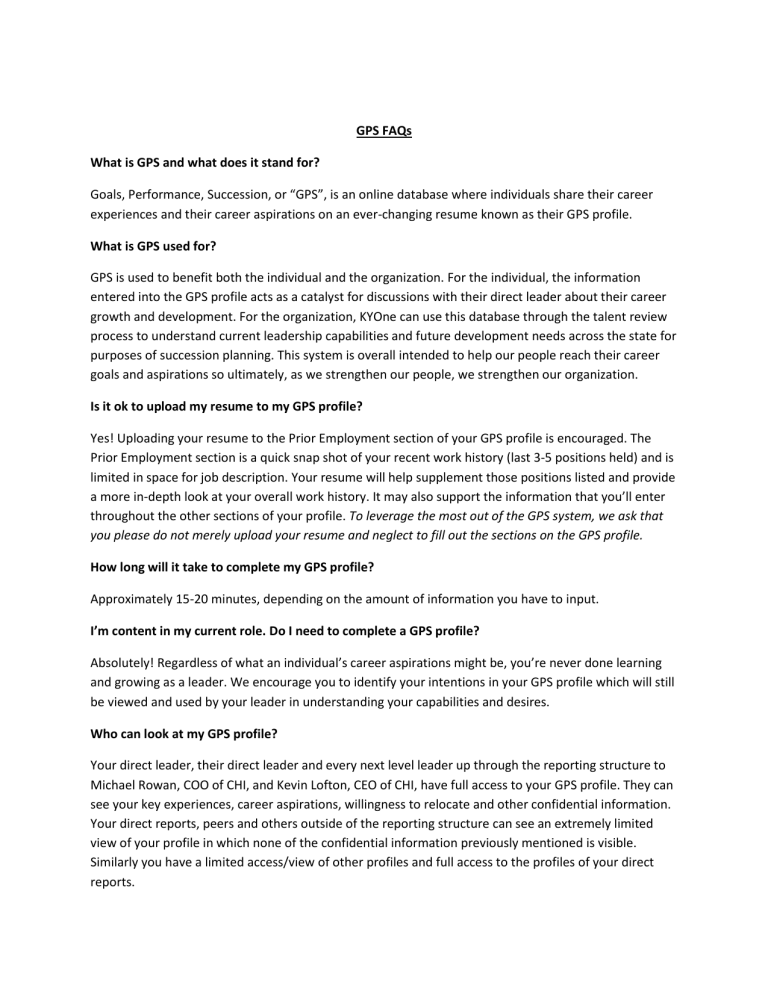GPS FAQs What is GPS and what does it stand for? Goals

GPS FAQs
What is GPS and what does it stand for?
Goals, Performance, Succession, or “GPS”, is an online database where individuals share their career experiences and their career aspirations on an ever-changing resume known as their GPS profile.
What is GPS used for?
GPS is used to benefit both the individual and the organization. For the individual, the information entered into the GPS profile acts as a catalyst for discussions with their direct leader about their career growth and development. For the organization, KYOne can use this database through the talent review process to understand current leadership capabilities and future development needs across the state for purposes of succession planning. This system is overall intended to help our people reach their career goals and aspirations so ultimately, as we strengthen our people, we strengthen our organization.
Is it ok to upload my resume to my GPS profile?
Yes! Uploading your resume to the Prior Employment section of your GPS profile is encouraged. The
Prior Employment section is a quick snap shot of your recent work history (last 3-5 positions held) and is limited in space for job description. Your resume will help supplement those positions listed and provide a more in-depth look at your overall work history. It may also support the information that you’ll enter throughout the other sections of your profile. To leverage the most out of the GPS system, we ask that you please do not merely upload your resume and neglect to fill out the sections on the GPS profile.
How long will it take to complete my GPS profile?
Approximately 15-20 minutes, depending on the amount of information you have to input.
I’m content in my current role. Do I need to complete a GPS profile?
Absolutely! Regardless of what an individual’s career aspirations might be, you’re never done learning and growing as a leader. We encourage you to identify your intentions in your GPS profile which will still be viewed and used by your leader in understanding your capabilities and desires.
Who can look at my GPS profile?
Your direct leader, their direct leader and every next level leader up through the reporting structure to
Michael Rowan, COO of CHI, and Kevin Lofton, CEO of CHI, have full access to your GPS profile. They can see your key experiences, career aspirations, willingness to relocate and other confidential information.
Your direct reports, peers and others outside of the reporting structure can see an extremely limited view of your profile in which none of the confidential information previously mentioned is visible.
Similarly you have a limited access/view of other profiles and full access to the profiles of your direct reports.
What is an effective development goal?
There are several aspects and criteria to an effective development goal. First and foremost, development goals need to be SMART. They need to be Specific, Measureable, Action-oriented,
Realistic, and Time bound. An effective development goal should be crafted to fit the needs of the individual and also benefit the organization. A development goal should be constructed with the guidance and advice of your direct leader and it is recommended that 1-2 development goals is an adequate amount.
Research has shown that the most impactful development comes from on-the-job learning like special projects but sometimes those situations do not exist. The classroom setting, which is a common venue to receive training/education for development, is not as effective as it was once believed to be. Having said that, training/education received in a classroom setting increases in effectiveness if you can quickly apply it to your everyday work.
The great thing about development goals is that they do not have to necessarily focus on an area in which you think you need improvement. A development goal can also focus on building upon current strengths or developing new skills altogether.





